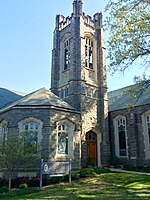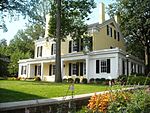Princeton Garden Theatre
1920 establishments in New JerseyBuildings and structures in Princeton, New JerseyCinemas and movie theaters in New JerseyTheatres completed in 1920

The Princeton Garden Theatre is a historic movie theater on Nassau Street in Princeton, New Jersey. Owned by Princeton University, it is operated by Renew Theaters, a non-profit which manages golden-age movie theaters. The theater shows first run movies of high artistic quality as well as classic and foreign language films, and Saturday kid's matinees. The Garden live broadcasts performances from the Royal National Theatre and host talks and lectures from filmmakers including Terrence Malick and Peter Saraf. In March 2017 the Garden was named New Jersey's best movie theater by NJ.com. It offers screenings for a number of area film festivals.
Excerpt from the Wikipedia article Princeton Garden Theatre (License: CC BY-SA 3.0, Authors, Images).Princeton Garden Theatre
Nassau Street,
Geographical coordinates (GPS) Address Nearby Places Show on map
Geographical coordinates (GPS)
| Latitude | Longitude |
|---|---|
| N 40.350685 ° | E -74.657581 ° |
Address
Garden Theater
Nassau Street 160
08542
New Jersey, United States
Open on Google Maps









